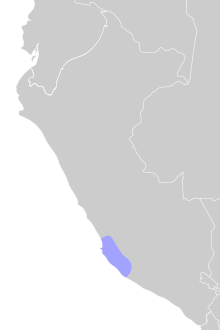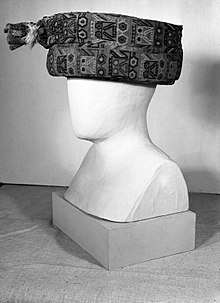Paracas culture
The Paracas culture was an Andean society existing between approximately 800 BCE and 100 BCE, with an extensive knowledge of irrigation and water management and that made significant contributions in the textile arts. It was located in what today is the Ica Region of Peru. Most information about the lives of the Paracas people comes from excavations at the large seaside Paracas site on the Paracas Peninsula, first formally investigated in the 1920s by Peruvian archaeologist Julio Tello.
 Area of development and influence of the Paracas culture. | |
| Period | Early Horizon |
|---|---|
| Dates | c. 800 BCE – 100 BCE |
| Major sites | Paracas Candelabra |
| Followed by | Nazca culture |
.jpg)
The Paracas Cavernas are shaft tombs set into the top of Cerro Colorado, each containing multiple burials. There is evidence that over the centuries when the culture thrived, these tombs were reused. In some cases, the heads of the deceased were taken out, apparently for rituals, and later reburied. The associated ceramics include incised polychrome, "negative" resist decoration, and other wares of the Paracas tradition. The associated textiles include many complex weave structures, as well as elaborate plaiting and knotting techniques.
The necropolis of Wari Kayan consisted of two clusters of hundreds of burials set closely together inside and around abandoned buildings on the steep north slope of Cerro Colorado. The associated ceramics are very fine plain wares, some with white and red slips, others with pattern-burnished decoration, and other wares of the Topara tradition. Each burial consisted of a conical textile-wrapped bundle, most containing a seated individual facing north across the bay of Paracas, next to grave offerings such as ceramics, foodstuffs, baskets, and weapons. Each body was bound with cord to hold it in a seated position, before being wrapped in many layers of intricate, ornate, and finely woven textiles. The Paracas Necropolis textiles and embroideries are considered to be some of the finest ever produced by Pre-Columbian Andean societies. They are the primary works of art by which Paracas culture is known. Burials at the necropolis of Wari Kayan continued until approximately 250 CE. Many of the mortuary bundles include textiles similar to those of the early Nazca culture, which arose after the Paracas.
Paracas mummy bundles
The dry environment of southern Peru's Pacific coast allows organic materials to be preserved when buried.[2] Mummified human remains were found in a tomb in the Paracas peninsula of Peru, buried under layers of cloth textiles.[3] The dead were wrapped in layers of cloth called "mummy bundles". These bodies were found at the Great Paracas Necropolis along the south Pacific coast of the Andes.[4] At the Necropolis there was a large communal tomb holding 420 bodies, dating to around 300–200 BCE.[5] The mummified bodies in the tomb were wrapped in textile fragments.[6] The textiles would have required many hours of work as each textile was extremely detailed. The larger mummy bundles had elaborate embroidery detail with bright colored cloth.[3][7] Jewelry and food were also found inside some mummy bundles.[3] The shape of the mummy bundles resembled seeds.[2]
According to Anne Paul, this shape could have been a conscious choice by the people, with the seed a symbol of rebirth.[3][7] Paul also suggests that the detail and high quality of the textiles found in the mummy bundles show that these fabrics were used for important ceremonial purposes.[2][7] The technique used for these textiles, called wrap and wrapping, involves a piece of colored fleece woven around pieces of cotton wrap threads before the weaving process.[2][3] The colored fleece was dyed before the weaving process and mixed with the white cotton. This combination of materials shows trading relationships with other communities at lower and higher elevations.[3] The wool came from camelids in the highlands (llama and alpaca); the cotton was grown in the warmer coastal valley.[3][7]
The imagery found on these textiles included ceremonial practices and spiritual journeys.[8] Some depicted a fallen figure, or possibly flying. Each figure appears to have face paint, possibly indicating different city states.[8] Each holds a severed head, also called trophy heads.[8] Victims' heads were often severed and collected during battles.[3] The heads were used for spiritual rituals. The head of a person was considered their life force, the place in the body where the spirit was located.[8] It is believed the fallen or flying figure represents a spiritual journey, perhaps showing a ruler priest on a spiritual journey or undergoing a type of spiritual transformation from the celestial world back to the terrestrial.[8] Not only did these textiles show important symbols of the Paracas cosmology, it is thought that they were worn to establish social standing, authority, and indicate the Paracas city state in which one resided.[2] These garments were brightly colored, with a palette of pinks, greens, yellows, red, purples, and whites, all of which would have been striking against the beige desert sands of the surrounding environment.[2]
The bright colors are another example of the extensive labor used to create these textiles. The dyes used came from across the Andes and are an example of reciprocity, as people from different altitudes traded with one another for different goods.[8] The color red comes from the cochineal bug found on the prickly pear cactus.[9] The cochineal was ground up with mortar and pestle to create a red pigment.[9] Yellow dyes could be made from the qolle tree and quico flowers, while orange dyes can be extracted from a type of moss called beard lichen.[9] For the color green the most common plant used is the cg'illca, mixed with a mineral called collpa.[9] While blues are created from a tara, the deeper a hue of blue, the more the mineral collpa was added.[9] The process of creating dyes could take up to several hours. Then it could take another two hours for women to boil and dye the fibers.[9] This work was followed by spinning and weaving the fibers.
The textiles and jewelry in the tombs and mummy bundles attracted looters.[5] Once discovered, the Paracas Necropolis was looted heavily between the years 1931 and 1933, during the Great Depression, particularly in the Wari Kayan section.[10] The amount of stolen materials is not known; however, Paracas textiles began to appear on the international market in the following years.[10] It is believed the majority of Paracas textiles outside of the Andes were smuggled out of Peru.[10]
Due to a lack of laws to preserve artifacts and against smuggling, thefts continued to increase, particularly of South American artifacts.[10] In 1970 UNESCO created the Convention on the Means of Prohibiting and Preventing the Illicit Import, Export and Transfer of Ownership of Cultural Property.[11]

Topara
While the Paracas culture developed in this region between approximately 1200 BCE and 100 BCE, the Topará culture is thought to have "invaded" from the north at approximately 150 BCE. The two cultures coexisted for one or more generations, both on the Paracas Peninsula and in the nearby Ica Valley. Their interaction played a key role in the development of the Nazca culture and its ceramic and textile traditions. Although the elaborate textiles have been preserved only in the coastal desert sites, there is growing evidence that the associated peoples of these cultures lived and traveled as well among the Pacific lowlands, the Andean highland valleys, and mountain pastures to the east.

Nazca culture
Nazca Culture and iconography are believed by scholars such as Helaine Silverman to have evolved from Paracas culture.[6]
Hendrik Van Gijseghem notes that Paracas remains in the Río Grande de Nazca drainage, the heartland of Nazca culture, are limited. He said that, in contrast, there are abundant Paracas remains in the Ica, Pisco, and Chincha valleys, as well as the Bahía de la Independencia. He noted that the southern Nasca region, which became the most populous region of its culture, was never an important area of Paracas occupation. He believes that initial settlement of the region by Paracas populations and subsequent population growth mark the beginning of Nazca society.[12]
Paracas geoglyphs
In 2018 RPAS drones used by archaeologists to survey cultural evidence revealed many geoglyphs in Palpa province. These are being assigned to the Paracas culture. Many have been shown to predate the associated Nasca lines by a thousand years. In addition, some show a significant difference in subjects and locations, for instance, being constructed on a hillside rather than the desert valley floor.[13] Additional research is being conducted on these geoglyphs.
References
- Bottle, Feline Face, 4th–3rd century BCE Metropolitan Museum of Art
- Paul, Anne (1991). Paracas Art and Architecture: Object and Context in Southern Coastal Peru. University of Iowa Press. pp. 678–679. ISBN 978-0877453277.
- Wallace, Dwight T. (1960). "Early Paracas Textile Techniques". American Antiquity. 26 (2): 279–281. doi:10.2307/276210. ISSN 1045-6635. JSTOR 276210.
- Paul, Anne (1990). Paracas Ritual Attire: Symbols of Authority in Ancient Peru. The Civilization of the American Indian Series. The University of Oklahoma. pp. 290–292. ISBN 978-0806122304.
- Proulx, Donald A. (2008), "Paracas and Nasca: Regional Cultures on the South Coast of Peru", The Handbook of South American Archaeology, Springer New York, pp. 563–585, doi:10.1007/978-0-387-74907-5_29, ISBN 978-0387749068
- Silverman, Helaine (December 1994). "Paracas in Nazca: New Data on the Early Horizon Occupation of the Rio Grande de Nazca Drainage, Peru". Latin American Antiquity. 5 (4): 359–382. doi:10.2307/971822. JSTOR 971822.
- Paul, Anne (1990). Paracas Ritual Attire: Symbols of Authority in Ancient Peru. University of Oklahoma Press. ISBN 978-0806122304. OCLC 925134619.
- Stone, Rebecca (2012). Art of the Andes: From Chavin to Inca. Thames & Hudson. ISBN 978-0500204153. OCLC 792747356.
- de Mayolo, Kay K. Antúnez (April 1989). "Peruvian Natural Dye Plants". Economic Botany. 43 (2): 181–191. doi:10.1007/BF02859858.
- Bird, Junius B. The Junius B. Bird Pre-Columbian Textile Conference, 1973, Washington D.C., May 19 & 20, 1973: abstracts of papers with illustrative slides. OCLC 46447979.
- "1970 Convention | United Nations Educational, Scientific and Cultural Organization". unesco.org. 2017. Retrieved 29 March 2019.
- Van Gijseghem, Hendrik (December 2006). "A Frontier Perspective on Paracas Society and Nasca Ethnogenesis". Latin American Antiquity. 17 (4): 419–444. doi:10.2307/25063066. JSTOR 25063066.
- Greshko, Michael, "Exclusive: Massive Ancient Drawings Found in Peruvian Desert", National Geographic, 05 April 2018
Further reading
- Paracas Art and Architecture: Object and Context in South Coastal Peru by Anne Paul, Publisher: University of Iowa Press, 1991 ISBN 0-87745-327-6
- Ancient Peruvian Textiles by Ferdinand Anton, Publisher: Thames & Hudson, 1987, ISBN 0-500-01402-7
- Textile art of Peru by Jose Antoni Lavalle, Publisher: Textil Piura in the Textile (1989), ASIN B0021VU4DO
External links
| Wikimedia Commons has media related to Paracas culture. |
- CIOA Field Report of a Paracas-period Site
- Paracas Textiles at the Brooklyn Museum
- Gallery of Paracas objects (archived link, text in Spanish)
- Impacts on Tourism at Paracas (in Spanish)
- Precolumbian textiles at MNAAHP (in Spanish)
- Paracas textile at the British Museum
- Ancient Peruvian ceramics: the Nathan Cummings collection by Alan R. Sawyer, an exhibition catalog from The Metropolitan Museum of Art (fully available online as PDF), which contains material on Paracas culture (see index)